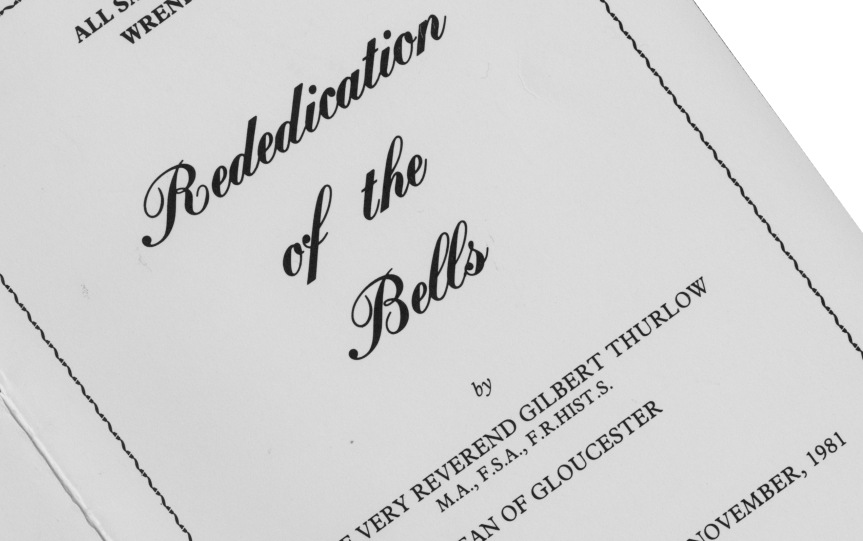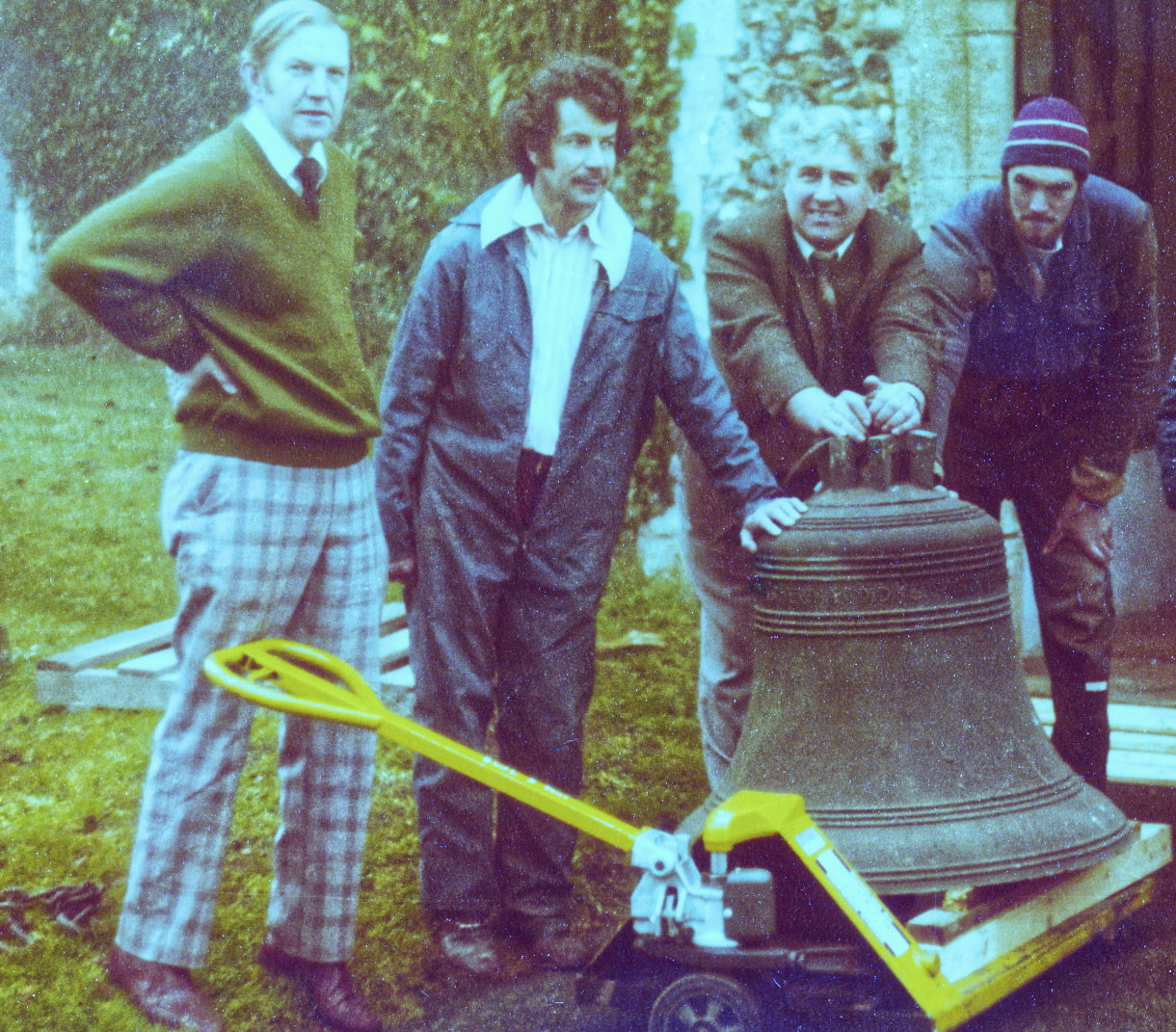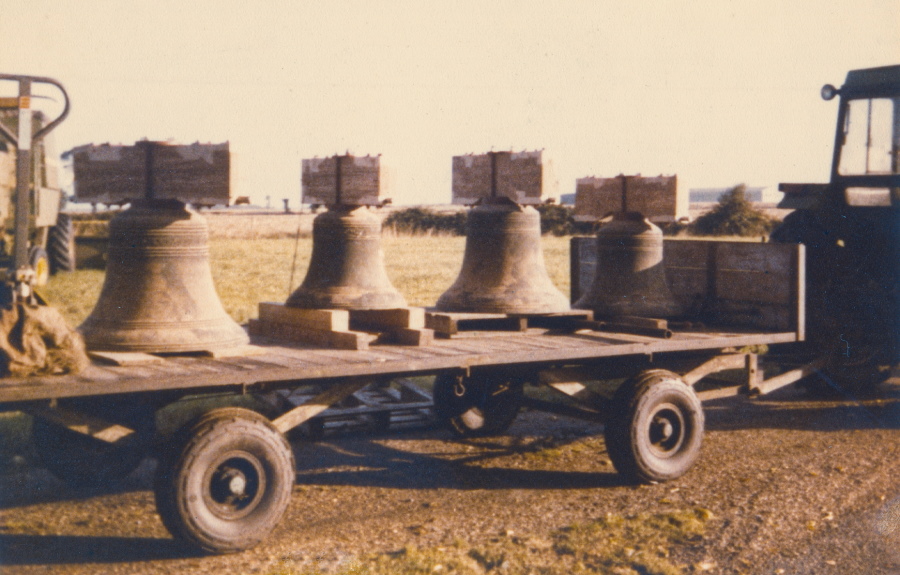The following text has been reproduced from the November 1981 Order of Service. The images are villager’s personal records from the time.

History of the Bells
Records show that in 1552 there were four bells in Wreningham Church. Previously one Margaret Newton left a legacy of 12 Pence for the Hallowing of the bells.
The treble bell weighs 2 cwts 3 qtrs 1-3 lbs
and has a cast inscription: THOMAS NEWMAN MADE MEE-1712.
The second bell weighs 3 cwts 3 qtrs 12 lbs also
with cast inscription: THOS NEWMAN MADE MEE -1714 – F. GOOCH, C.W.
The third bell was recast in 1878 by John Warner & Sons, London,
and weighs 5 cwts 0 qtrs 17 lbs. This was originally cast by Brazyer
at the Norwich Foundry in the 15th century and was inscribed:
+ QUESUMUS ANDREA FAMULORUM SUSCIPE VOTA
(We Pray Thee, Andrew Receive The Vows Of Thy Servants).
The tenor bell weighs 6 cwts 3 qtrs 24 lbs and is inscribed:
THOMAS NEWMAN DID ME CAST ILE SING HIS PRAISE VNTO THE LAST-1712.
Thomas Newman’s foundry was at Norwich but he is supposed to have travelled, setting up his foundry whenever there were bells to be cast. It may therefore be assumed there have been various previous
bell projects – in 1508, 1712, 1852-3 when the tower fell and the church renovated, and in 1878.
Wreningham Church Bells in 1981

John Pruce is on the left.

The re-dedication of the bells of the church of All Saints, Wreningham by the Very Rev. Gilbert Thurlow, M.A., F.S.A., F.R.HIST.S on Sunday 8th November 1981, marked the completion of a project first brought before the Parochial Church Council in 1963 and further discussed in 1966. In 1977 the council applied for a faculty to carry out renovation, which was granted and work was started in preparation for removal of the bells from the tower. The plan involved the use of as much local voluntary help as possible.
The bells were lowered inside the tower and transported to Taylor’s bell foundry at Loughborough where the canons were removed, plates made and the bells drilled in preparation for bolting to new headstocks. Crown staples were removed and fitted with new clappers and fittings. They were then tuned to a peal and returned to Wreningham. New headstocks and metal fittings were made and fixed by local craftsmen. Thence the bells were replaced in the tower, the bell-frame having been repaired and treated. Also a safety cage was fitted to the lower ladder. Pulley blocks were also made locally and new ropes have been fitted. The vestry has been renovated to complete the scheme.
It should be recorded that the BARRON BELL TRUST contributed £200 to this work.
The new headstocks have been given in memory by relatives and inscribed as follows:
| 1. DEDICATED TO THE MEMORY OF ANDREW JOHN RICHARDSON, 1963-1979 (YOUTH) |
| 2. IN MEMORY OF ALICE PANSY ROWE, 1888-1972 (SCHOOL TEACHER) |
| 3. IN MEMORY OF ROBERT HERBERT NICHOLS, 1898-1978 (BELL RINGER) |
| 4. IN MEMORY OF JOHN ROBERT HANTON, 1889-1973 (CHURCHWARDEN) |
It is appropriate to remember with gratitude the late John Pruce who played a major part in the work undertaken by local craftsmen.
Reverend H. B. L. Brierly – Rector
Dennis A Long & Kenneth Hanton – Churchwardens
The 1977-1981 Bell works – and who did what:
Whilst the core activity was carried out by the bell foundry, most of the supporting tasks were undertaken by a team of villagers using their own skills and resources.
Dropping (and later lifting) of the bells was undertaken by Dennis Long with a group of locals. After being collected from the foundry by Russell Harvey’s men, the repaired and tuned bells – complete with their new clappers, were taken to the Wreningham workshop of Ian Foster.
Ian made the new headstocks from elm with the help of J…(?) Marshall. Metal works and fittings were manufactured by villager John Pruce and his staff at their Wymondham premises.
Russell Harvey’s team had meanwhile renovated the bell frame in the tower. Dennis Long, with tractor and trailer, returned the bells to the church where they were raised and received the final works by Ian Foster.
The operation was aided by Paul Cattermole at the Norwich Diocese whilst much of the general co-ordination and support was undertaken by Ken Hanton.
